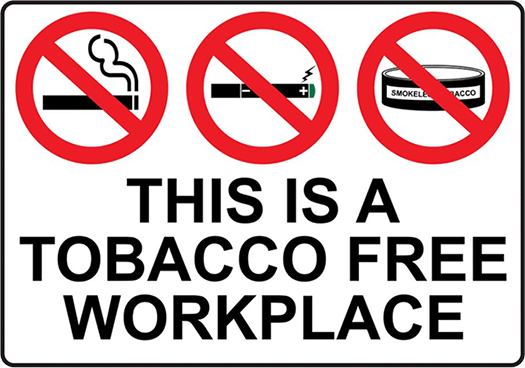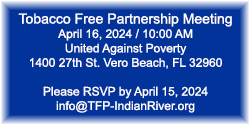News and Events
What Makes a Tobacco Free Worksite Policy different today from Florida’s Clean Indoor Air Act?
September 15, 2017
Passed in 1985, the Florida Clean Indoor Air Act had several requirements for worksites. When enacted it provided a uniform statewide code to regulate the use of cigarettes in enclosed indoor workplaces, as well as creating areas in public places and at public meetings that are reasonably free from tobacco smoke. The owner in charge of an enclosed indoor workplace is required by this statute, to implement an indoor workplace policy prohibiting smoking. Originally the policy would prohibit an employee from smoking in the enclosed indoor workplace and it may have included procedures to be taken when there is a smoking violation.

Why should today’s Tobacco Free Worksite (TFW) policy differ from a No Smoking policy mandated in 1985? Since the Clean Indoor Act was passed 32 years ago, a lot has changed. Can you imagine life without email, smart phones or FaceBook? The tobacco industry and what we know about the harmful effects of tobacco has changed too. New research shows tobacco use contributes to more cancers throughout the body, not just in the lungs or throat. Tobacco use, even secondhand smoke, constricts blood vessels so much, it increases heart disease, heart attacks, and causes strokes. The tobacco industry has made some tobacco products more addictive, making it harder to quit. The industry is rapidly developing new tobacco products which may not be covered by old policies. Since there are no studies on the long-term health effects of electronic smoking devices, today’s worksite policy should cover the use of electronic cigarettes. Disposable and refillable e-cigarettes are not the only new product on the horizon. Phillip Morris recently submitted a new device to the FDA that heats tobacco leaves and produces vapor, not smoke. The device is called IQOS, which stands for “I Quit Ordinary Smoking”.
Just as other business practices have changed, policies should evolve and not remain stagnant. Standards in Human Resources for organizations, businesses, and non-profits have changed too. Employees are increasingly recognized as an organization’s biggest asset and employers are increasingly aware of the effects (think: costs) of employee health on their bottom line. Research shows us that 70% of people who DO smoke, want to quit. Add in the smokers who want to quit, to 84% (on average) or more employees who do not smoke, and you get a lot of support for a Tobacco Free Worksite policy that benefits all employees. Smokers are never required to quit, and some may never wish to quit. However, a policy that limits opportunities to smoke during working hours provides the opportunity for improved health.
When employees take additional time out of their work schedule to smoke, the number one cost to an employer is lost productivity. On average, extra break time taken by employees, costs employers 8% of that person’s wages on top of losing that employee’s productivity while they take time to smoke. Tobacco Free Worksite policies that require all employees to have the same length and number of breaks during working hours, increases productivity, and that alone has a positive effect on the organization’s bottom line. An updated policy is capable of improving employee morale when all smoking and non-smoking employees are treated equitably. Who usually takes up the slack while a smoker goes on break?
At this point, you may be asking yourself, “How do I get employees to quit smoking?” Employees should never be required or asked to quit. To reduce employee smoking, you may set rules about the number and length of breaks while they are at work. You may prohibit tobacco use while on duty or while using company vehicles. If you provide health insurance, you may require tobacco users to pay more than non-users. You may prohibit smoking within 25’ of the property or even prohibit all tobacco use on your property. You may consistently communicate information on tobacco cessation and participate in Great American Smoke Out activities. All of these resources and more, are available from your local Tobacco Free Partnership.
To update your Tobacco Free Worksite Policy, contact the Tobacco Free Partnership of Indian River County at info@tfp-indianriver.org.




